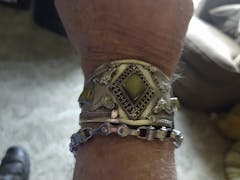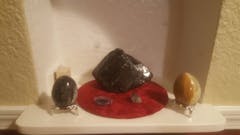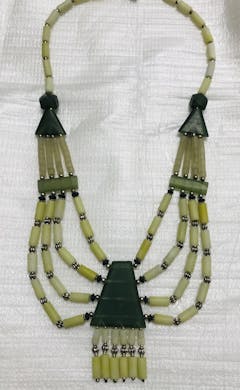2438g, 12.75"x8.5"x0.9" Red Shell Fossils Orthoceras Ammonite Sculpture @Morocco, B8563
Weight: About 2438 Grams ( 5.38 Lbs)
Height: About 12.75"
Width: About 8.5"
Thickness: About 0.9"
Location of Origin: Atlas Mountains, Morocco
Age of Fossils: 240 Million -500 Million Years Old or So
***Buyer will receive the exact item as pictured! Look at images carefully before purchasing. Images from all sides and angles are taken to show the exact item.
Look at images carefully. Crack looking lines, fractures looking lines are common and normal in natural stones, fossils & crystals. Those lines don't mean they are broken lines. They are natural. These handicrafts, uneven, scratches, wears & tears, chips, repairs, miss match of pairs, unequal sizes, weights and other factors of imperfections are very common.
Actual item may differ slightly than the images due to image quality, lightning, resolutions, contrast, zooming, computer screens and many other factors. However, in most cases, actual items look better than the images.
Wikipedia:
Ammonites (pronunciation: /ˈæmənaɪts/) are an extinct group of marine mollusk animals in the subclass Ammonoidea of the class Cephalopoda. These mollusks are more closely related to living coleoids (i.e., octopuses, squid, and cuttlefish) than they are to shelled nautiloids such as the living Nautilus species. The earliest ammonites appear during the Devonian, and the last species died out during the Cretaceous–Paleogene extinction event.
Ammonites are excellent index fossils, and it is often possible to link the rock layer in which a particular species or genus is found to specific geologic time periods. Their fossil shells usually take the form of planispiral, although there were some helically spiraled and non-spiraled forms (known as heteromorphs).
The name "ammonite", from which the scientific term is derived, was inspired by the spiral shape of their fossilized shells, which somewhat resemble tightly-coiled rams' horns. Pliny the Elder (d. 79 AD near Pompeii) called fossils of these animals ammonis cornua ("horns of Ammon") because the Egyptian god Ammon (Amun) was typically depicted wearing ram's horns.[1] Often the name of an ammonite genus ends in -ceras, which is Greek (κέρας) for "horn".
Orthoceras ("straight horn") is a genus of extinct nautiloid cephalopod. This genus is sometimes called Orthoceratites. Note it is sometimes misspelled as Orthocera, Orthocerus or Orthoceros (Sweet 1964:K222).
Orthoceras fossils are common and have a global distribution, occurring in any marine rock, especially in limestone.
These are slender, elongate shells with the middle of the body chamber transversely constricted, and a subcentral orthochoanitic siphuncle. The surface is ornamented by a network of fine lirae (Sweet 1964:K224). Many other very similar species are included under the genus Michelinoceras.

























